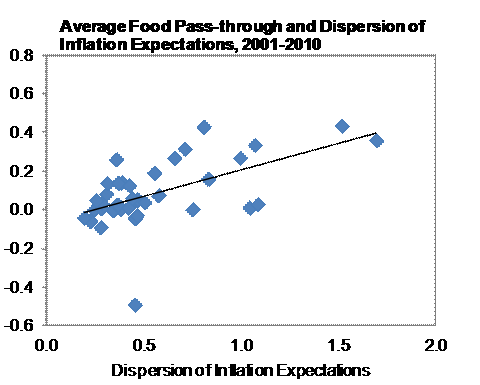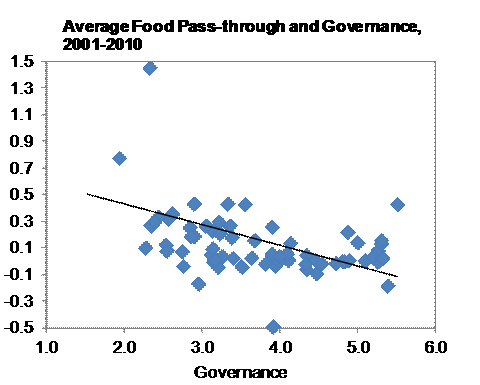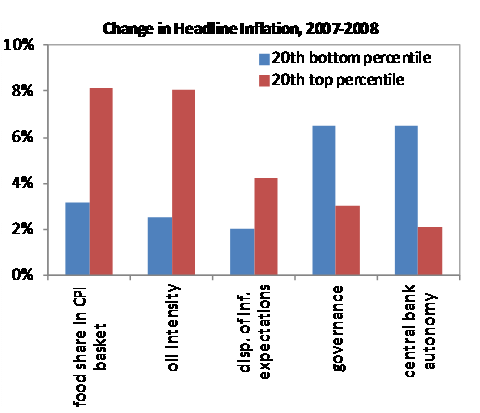Today, we are fortunate to have a guest contribution from Gaston Gelos, Advisor in the IMF’s Institute for Capacity Development, and Yulia Ustyugova, Economist in the IMF’s Western Hemisphere Department.
Commodity prices have been particularly volatile during the last decade. They set off on a multi-year rally around 2003, peaked in 2008, plummeted with the global recession, recovered quickly, and surprised recently with renewed surges. They fueled inflationary pressures in economies around the globe and have challenged policymakers striving to find the appropriate policy response. They have also prompted a new debate about which structural characteristics and policy frameworks help economies contain the inflationary effects from commodity price shocks.
With this motivation, we examined inflation dynamics for 31 advanced and 61 developing economies. We assessed average pass-throughs of international food and fuel prices to domestic inflation in 2001-2010 using both country-by-country and panel estimations of augmented Phillips curves. We then related the size of the pass-throughs to country characteristics and policy frameworks. We also studied the cross-country performance of headline and core inflation around the 2008 commodity price shock, as the dynamics may be different around large shocks.
Our findings confirm the presumption that food price shocks have stronger inflationary effects in countries with higher food weights in the CPI basket. During 2001-2010, a ten percentage-point shock to international food prices, for example, was associated on average with a 1.4 percentage-point increase in inflation for countries with the highest (top 20th percentile) shares of food in their CPI basket, while the pass-through in the bottom 20th percentile was only 0.3 percentage points. Similarly, external fuel price shocks had stronger inflationary impact in highly oil-intensive economies.
Several other factors that are generally believed to affect the pass-through, however, did not seem to play an important role. Neither financial development nor financial dollarization appeared to significantly influence the way to which domestic inflation responded to international commodity price fluctuations over 2001-2010 and around the 2008 shock. We could not document a statistically significant relationship between labor market flexibility and the pass-through of commodity price shocks to domestic inflation, either. Similarly, the degree of trade openness was not generally related to the size of the pass-through; although there is some indication that global fuel price dynamics have had a higher effect on domestic prices in more open developing economies.
Countries with higher pre-existing inflation levels clearly experienced higher pass-throughs. Our estimations show that around the 2008 shock, economies with an initial inflation above 10 percent saw, on average, a six-percentage point higher rise in CPI inflation than countries with a pre-existing inflation below 10 percent. Also, over the 2001-2010 period, a ten percentage-point global food price increase translated on average into one percentage point higher CPI inflation in countries where inflation exceeded 10 percent, than in countries with lower initial inflation rates. This is in line with Taylor (2000), who argued that the extent to which firms respond to increases in costs of other prices by raising their own price depends on how persistent the increase is expected to be. Thus, low and more stable inflation should be associated with a less persistent inflationary impact of commodity price shocks. In addition, there is some indication that a smaller dispersion of inflation expectations (a proxy for the degree of anchoring of inflationary expectations) is associated with lower inflationary pass-throughs.

Our analysis suggests that better overall governance and greater central bank autonomy help anchor inflation expectations and reduce second-rou nd effects of international commodity price shocks. Countries with better governance frameworks (even after controlling for the presence of inflation targeting regimes) and more autonomous central banks experienced a smaller inflationary impact of commodity price shocks over the period 2001–2010 and during the 2008 food price shock.

The results for the effect of inflation targeting regimes were weaker than expected. The average effect of inflation targeting regimes on the inflation response to commodity price pressures was estimated to be statistically significant, but modest. A ten-percentage-point increase in international fuel price inflation, for example, was associated with only a 0.2 percentage point lower long-term inflationary impact for inflation targeters. Moreover, the evidence for the inflation outcomes following the large 2008 commodity price shock suggests that inflation targeters were not significantly better able at dampening the impact of commodity price shocks on headline and core inflation.

Our findings therefore suggest that the overall confidence in institutions may be more important than whether a country formally declares itself an inflation targeter or not.
References:
Gelos, G, and Y. Ustyugova, 2012, “Inflation responses to commodity price shocks – how and why do countries differ?” IMF Working Paper 12/225 (Washington: International Monetary Fund).
Gelos, G, and Y. Ustyugova, “When commodity prices soar,” Finance and Development, December 2012 (Washington: International Monetary Fund).
Taylor, John, 2000, “Low Inflation, Pass-Through, and the Pricing Power of Firms,” European Economic Review, Vol. 44, No. 7, pp. 1389–408.
This post written by Gaston Gelos and Yulia Ustyugova. Disclaimer: The views expressed herein are those of the authors and should not be attributed to the IMF, its Executive Board, or its management.
Points to be looked after
UNDP recommends in few of its reports, inflation to be recorded under Laspeyres formula. The above statistical formulation is inflation friendly, to be read among others Econbrowser reviews and comments on the topic. Plainly, if because of food prices increases, one does not drink milk anymore and does use substitute protein products no inflation impact is recorded. The sample covered in this paper is large enough to accommodate this finding in few countries.
Note as well, the core of the study is not the commodities inflation in absolute value but the pass through of commodities prices. How much may be digested of prices commodities increases and how flexible are Phillips curves in Zimbabwe.
Countries governance and prices inflation seem to be a happy mix of philosophical concepts and remain to be accurately quantified prices. The wedding of J. Solpartre with an accountant or a more modern version lady gogo bride of a central bank governor.
A good reading, but the clouds are very low in the cathedrals of economics.
Interesting. Shattered an illusion or two of mine, otherwise confirms the pre-existing bias in favour of the benefits of low, stable rates of inflation.
I have usually thought of commodity price changes since the turn of the century as being one-time relative price changes, not inflation per se. That may describe the North American experience but apparently not countries with pre-existing higher rates of inflation.
Regardless, now that the US federal reserve has issued a clear unemployment rate target, I expect commodity prices to stay relatively high, perhaps go higher. Resource-levered investors will no doubt regard the policy as the new and improved dual-mandate put.